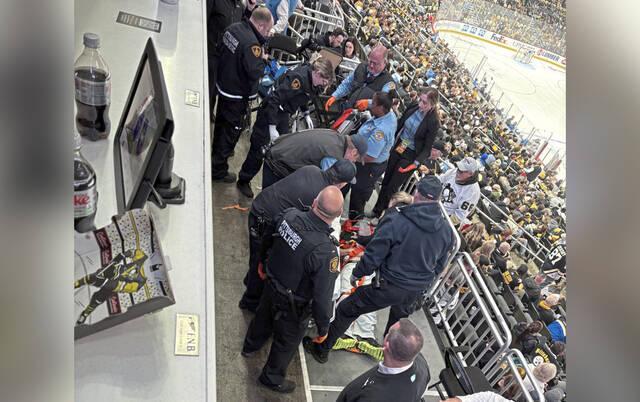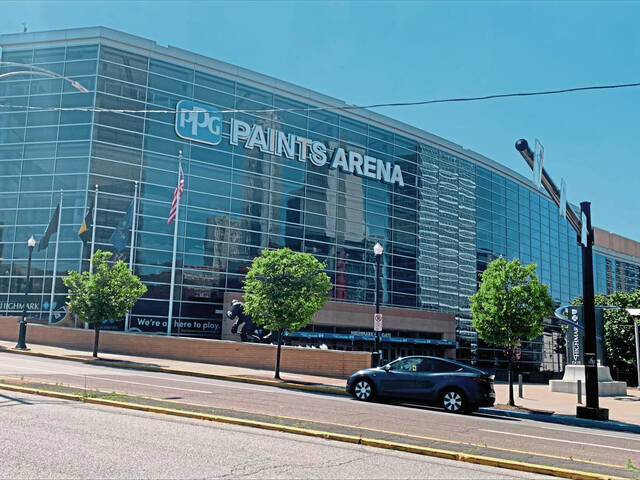Dizzying heights at venues like PPG Paints Arena unsettle upper-level spectators
For Pittsburgher Fabian Carrazana, going to a hockey game or concert means braving the vertigo-inducing pitch of PPG Paints Arena.
“The upper bowl is terrifying,” Carrazana said Wednesday, two days after witnessing a man at a Pittsburgh Penguins game suffer life-threatening injuries after falling from the venue’s upper level.
“It’s so steep, and, by the time you get to the upper bowl, all the seats are so close together, and there are no barriers between those seats,” Carrazana of Beechview told TribLive. “It’s always concerning, being up there.”
Carrazana is hardly alone feeling unsafe in the nose-bleed seats of the 15-year-old arena.
Across the country there are horror stories of spectators tumbling over railings, flipping onto fields and dropping onto concrete.
Falls and injuries are part of life at modern-day stadiums, where engineers and designers have worked to boost attendance and improve “fan experiences” by packing more bodies into new arenas, according to experts.
The results often include steeper steps, less arm and leg room between seats, and concerns about safety measures such as railings.
The PPG Paints Arena incident was the third of its kind since April in Pittsburgh, following one each at PNC Park and Acrisure Stadium.
“I always thought I was just a bit afraid of heights as a kid at my local arena,” a Reddit user named TheDuchin wrote in a Pittsburgh-themed thread Monday. “But as an adult, I can say they really do all (feel) like that.”
Reddit user LarryTheTerrier chimed in to express similar unease.
“I outright refuse to sit in the front row of upper bowls anywhere,” he wrote. “(It) scares me to death.”
On Wednesday, after the Penguins scored a goal around 7:15 p.m., Carrazana watched a man two rows ahead of him in Section 234 trying to return to his seat. The man was working his way upward, struggling as he made his away across rows of empty seats, according to Carrazana, who said he was sitting nearby.
“He started falling onto the bleachers, and every time he was trying to get his footing, he’d step on a seat and the seat would flip over,” Carrazana told TribLive. “Then, it just progressively got faster and faster.”
The man ended up falling back toward the upper-level railing at the lip of the arena’s upper bowl, tumbling into a pane of glass, Carrazana said.
Suddenly, the glass cracked. The man lay against it for a few seconds, Carrazana said.
“Then,” he said, “the glass gave way.”
The man, who has not been publicly identified, plunged about 35 feet. He struck a person in the suite level below him and then landed in the venue’s 100 level, Pittsburgh police said.
He was hospitalized in critical condition. Authorities did not release additional information Wednesday.
The Penguins did not respond to multiple emails and phone calls Tuesday and Wednesday.
On Thursday, after this article was posted, the Penguins and Oak View Group, the arena’s managing partner, clarified details about the fall and said their “collective thoughts” were with the victim.
The two groups “can confirm the patron was not using the designated staircase at the time of the incident,” the prepared statement read. “And the safety barrier remained intact.”
All safety barriers follow “building and safety codes and have been properly maintained,” the statement said. “The facility is inspected annually and remains safe for all guests.”
Jennifer Bullano Ridgley, a Penguins spokeswoman, declined to answer any questions Thursday.
Keeping mum
Robert Swint, a North Hills native and former NASA engineer, has examined videos and photos of Monday’s fall in Pittsburgh from Houston, where he works as CEO of a private firm specializing in forensic engineering and accident reconstruction.
He questioned whether the height of the barrier that Carrazana said gave way was sufficient.
“That makes the ability to balance yourself tough — you’d just fall over,” Swint said. “When you’re coming down that stairway, it should be protected. Because people will fall.”
Swint described stadiums as “complex structures” and said building codes are not uniform from one site to the next.
A spokeswoman for Pittsburgh Mayor Ed Gainey has maintained the steps, railings and other features at PPG Paints Arena were built according to applicable codes.
The Sports and Exhibition Authority, a joint Pittsburgh and Allegheny County entity, owns and leases Acrisure Stadium, PPG Paints Arena and PNC Park. The authority has not responded to multiple phone calls and emails about the angle of the upper concourse’s steep steps or other design matters.
“The SEA does not manage day-to-day venue operations or event production,” said state Sen. Wayne Fontana, D-Brookline, chairman of the authority’s board. “Neither I nor the SEA should speak for the Penguins.”
The Penguins did not respond Wednesday to multiple phone calls and emails.
Pittsburgh Councilman Anthony Coghill, D-Beechview, who serves on the authority board, said Wednesday he was “not in a position to comment just yet.”
“At any stadium, basically, there’s always going to be room for an accident like that,” Coghill told TribLive.
‘Death stairs’
A reputation for steep steps casts a pall over other sports venues.
Many sports fans point to the bleachers in São Januário, a soccer stadium in Rio de Janeiro.
They are “definitely death stairs if you don’t look before you step,” one Facebook user, Clara Brandão, posted recently.
There’s even a Facebook group that chronicles steep-step woes: “Death Stairs.” As of Wednesday afternoon, it boasted more than 996,000 members worldwide.
Rachel Tarentino posted a photo of PPG Paints Arena steps to the group’s feed last year.
“The picture doesn’t do them justice, they are STEEP,” Tarentino wrote.
“PPG Paints Arena Pittsburgh: I would not get drunk here,” Aaron Crook added.
The steep steps at Barclays Center, the home of the NBA’s Brooklyn Nets, have triggered multiple lawsuits.
In 2017, a man named Kenneth Silver sued the New York City stadium and its management after someone fell on top of him during a hockey game there, according to court documents.
The man’s attorney, Dean Vigliano, said the fall “was caused by the dangerous conditions” such as “narrow aisles, inadequate room between seating rows, an unreasonable steep incline and poor lighting.”
“It is steep there,” Vigliano told TribLive this week. “And it’s dark — I don’t think there’s any lighting in the aisles.”
Silver settled the matter out of court for “a nominal amount of money,” his attorney said. “There was no admission of liability, which is something they never do.”
Barclays Center officials did not respond to emails or phone calls this week seeking comment.
Cramming them in
It’s hard to measure the human impact of falls in stadiums. There is no central database tracking how many sports fans or concertgoers are seriously injured or killed each year inside these quasi-public spaces.
The internet, though, is not suffering from a lack of examples.
In 2013, a football fan fell to his death from a Candlestick Park walkway during a San Francisco 49ers game. Three years later in Denver, a spectator died after falling from a “severe height” at Mile High Stadium.
In Pittsburgh in 2022, a Beaver County man died after falling from an escalator at Acrisure Stadium after a Steelers game.
Two recent Pittsburgh incidents have generated headlines.
On April 30, a Pittsburgh Pirates fan who had been drinking alcohol fell 21 feet from the Clemente Wall to the right-field warning track at PNC Park.
The fan, Kavan Markwood, said he fell while celebrating an Andrew McCutchen double. Markwood called TribLive while still hospitalized and described his injured back and neck as “broken everything.”
This past Saturday, a worker at Acrisure Stadium was hospitalized with severe injuries after falling about 50 feet from the main scoreboard, according to Pittsburgh police.
Katie Sharpe knows the dangers of modern-day stadiums too well.
Her younger brother, Ronald Homer Jr., died after falling 85 feet from the upper deck of Turner Field in Atlanta in 2013. A sports triple threat, Homer — who stood 6-foot-7 and played football, baseball and basketball in high school — regularly attended Atlanta Braves games.
After Homer’s death, Sharpe said, she developed a “horrible” fear of heights. As she battled that, Sharpe also consulted with industry experts about her brother’s death.
“I looked through everything. I pulled autopsy reports. I looked at schematics,” said Sharpe, 47, of Darien, Ga., a coastal town about an hour’s drive north of Jacksonville, Fla. “I mean, this was devastating for our family. He was just 30.
“But we didn’t want to go and drag this all out, go through all these lawsuits and stuff.”
Swint, the former engineer based in Houston, said it’s unclear how stadium management responds to incidents like Monday’s fall.
“There are design limitations when you’re trying to get a massive amount of people into a small area,” Swint said Wednesday. “I think there’s an issue here. There’s no question about that.”
Justin Vellucci is a TribLive reporter covering crime and public safety in Pittsburgh and Allegheny County. A longtime freelance journalist and former reporter for the Asbury Park (N.J.) Press, he worked as a general assignment reporter at the Trib from 2006 to 2009 and returned in 2022. He can be reached at jvellucci@triblive.com.
Remove the ads from your TribLIVE reading experience but still support the journalists who create the content with TribLIVE Ad-Free.


